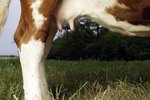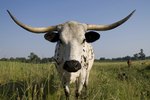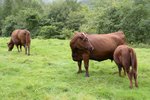At first glance, Dutch Belted and Belted Galloway cattle look much alike. However, if you saw a specimen from each breed standing beside each other, you'd spot obvious differences despite their similar coat patterns. The Dutch Belted is a dairy breed, while the Belted Galloway was developed for beef production. Both types of cattle are listed with the American Livestock Breeds Conservancy, which promotes conservation of threatened heritage breeds.
Dutch Belted Cattle
Known in their native Holland as the Lakenvelder, most Dutch Belted cattle are black with distinctive large, white belts around their trunks. Red and white coloring is also found. Dutch Belted bulls might weigh as much as 2,000 pounds at maturity, while cows are considerably smaller at 900 to 1,500 pounds. Both sexes naturally sport long horns, although many are polled shortly after birth. The Dutch Belted breed was almost lost during the 1970s, but numbers have increased because of the dedication of breeders and a revived interest on the part of farmers for grass-based dairy cows.
Advantages
The Dutch Belted is an efficient producer, able to convert relatively small amounts of grass into large amounts of milk. Heifers can be bred as early as 14 months of age, annually producing healthy calves well into their teens and thus continuing milk production. Crossbreeding with Dutch Belted bulls produces significant hybrid vigor in the resulting calves, according to the Dutch Belted Cattle Association of America. Because of the breed's rarity, the DBCAA does not recommend outcrossing using Dutch Belted cows.
Belted Galloway Cattle
Originally from Scotland, Belted Galloway cattle are smaller than Dutch Belteds, bulls averaging about 1,600 pounds and cows about 1,000 pounds. The general Galloway breed is black, and solid black calves still sometimes result from the mating of two Belted Galloway cattle. It's possible that cross-breeding with the Lakenvelder back in the 1700s produced the tell-tale white belt in some Galloway stock. Belted Galloway cattle are naturally polled, born without horns.
Attributes
Belted Galloways are double-coated, allowing them to thrive in harsh winter climates. This wavy coat sheds in summer, so they do well in fairly warm climates -- more so than breeds originating from colder regions. Renowned for their browsing ability, the hardy Belted Galloway can consume various types of natural forage while causing little land damage. The carcass produces a high quality and quantity of meat.
References
- Oklahoma State University: Dutch Belted (Lakenvelder)
- Dutch Belted Cattle Association of America: The Dutch Belted Breed
- American Livestock Breeds Conservancy: Dutch Belted Cattle
- Oklahoma State University: Belted Galloway
- U.S. Belted Galloway Society: History and Attributes of the Belted Galloway
- American Livestock Breeds Conservancy: Belted Galloway Cattle
Writer Bio
Jane Meggitt has been a writer for more than 20 years. In addition to reporting for a major newspaper chain, she has been published in "Horse News," "Suburban Classic," "Hoof Beats," "Equine Journal" and other publications. She has a Bachelor of Arts in English from New York University and an Associate of Arts from the American Academy of Dramatics Arts, New York City.




